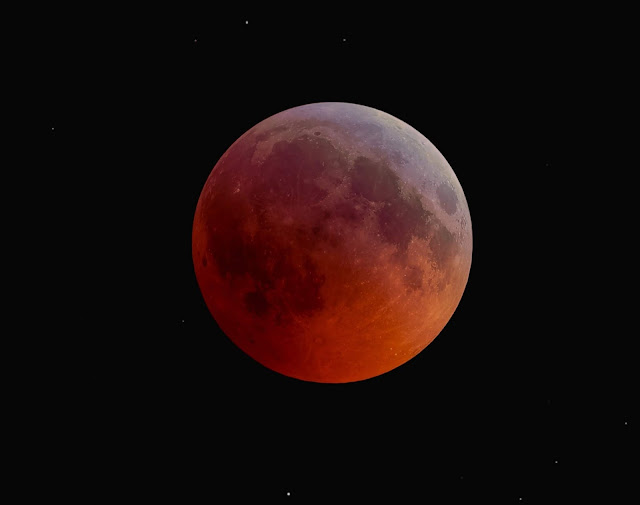 |
| Total lunar eclipse @ 05.00h, 21-01-2019 |
Distance: 357730 km (222282 miles)
Date: January 21st. 2019
Equipment: Canon 450D, Vixen 114mm f5.3 ED114 refractor, NEQ6 mount
Subframes: 20 x 1/2s @ ISO800, stacked and sharpened in Registax 2.1.14Equipment: Canon 450D, Vixen 114mm f5.3 ED114 refractor, NEQ6 mount
The excitable UK
press had billed this celestial event as a “Super-Blood-Wolf-Moon” or some such
gibberish.
During this lunar eclipse, the moon was close to perigee,
the closest point to Earth in its orbit, making the moon appear slightly larger
than usual. This phenomenon has been dubbed a “supermoon” by the popular press,
and is not an official astronomical term. Of the possible 12 or 13 full (or new) moons
each year, usually three or four may be classified as supermoons, so they are
not particularly rare. Even then, a full moon at perigee appears only about 14%
larger in diameter than at apogee, a difference that is barely discernible to the visual observer.
The popular press now also seems to call lunar eclipses “blood
moons” because of the way the Moon can turn a deep coppery red colour during
its eclipse. The effect is caused by atmospheric dust scattering higher
frequency blue light waves, but allowing the longer wavelength of red light to
come comes through. A similar effect is
in evidence just as the moon rises above the horizon, where the moon’s light
has to travel through a deeper layer of dust-laden air.
Until recently I hadn’t heard of the term “blood moon”, but
I guess the popular media like it because it sounds dramatic. They also threw the term “wolf
moon” in there, enabling them to depict Earth’s natural satellite as undergoing
some B-movie werewolf transition.
Native American Indians have traditional names for all of
the full moons throughout the year: January’s full moon is called the “Wolf
Moon”. If the eclipse had occurred in March, the press would have been
disappointed: “NotSoSuperBloodWormMoon” doesn’t sound quite as dramatic.
The colour of the Moon during totality depends on the global
state of dust in the Earth’s atmosphere; sometimes it is so dark a red as to
render the moon virtually invisible.
This particular eclipse was not as dark as the one of
September 2015 and was clearly visible despite the misty, damp and freezing (-4°C) conditions of the
Medway valley adding to a high cloud haze.
This seems to have added its own palette to the few images I was able to
get between clouds, which cleared just enough at 5 a.m. to show an unusual blue
tint to the brighter edge of the fully eclipsed moon.
The next total lunar eclipse that will be completely visible in
the UK
is not until 20th/21st of December 2029. Approximate timings for the south-east of England are
as below:
Moon enters penumbra: 19:40
Moon enters umbra: 20:55
Start of totality: 22:15
Maximum eclipse: 22:40
End of totality: 23:10
Moon leaves umbra: 00:30
Moon leaves penumbra: 01:40
The eclipse will be well-placed for observing (conditions
permitting!), being high up on the Orion/Gemini/Taurus border.
No comments:
Post a Comment